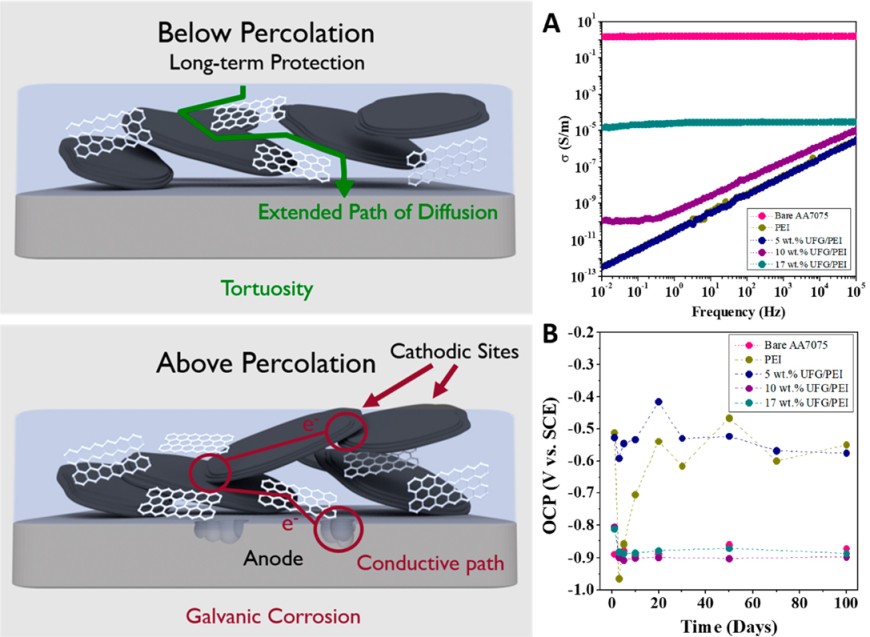Tortuosity but not percolation: design of exfoliated graphite nanocomposite coatings for extended corrosion protection of aluminum alloys
New Publication in “ACS Applied Nano Materials”
2019/06/02

Authors: Rachel D. Davidson, Yenny Cubides, Cole Fincher, Peter Stein, Chelsea McLain, Bai-Xiang Xu, Matt Pharr, Homero Castaneda and Sarbajit Banerjee
Increased adoption of engineered aluminum alloys in vehicular components is imperative for automotive lightweighting, but such alloys are oftentimes prone to degradation upon exposure to corrosive environments. The design of coatings to inhibit corrosion of aluminum alloys has emerged as a critical need but given the electropositive nature of the substrates, only a sparse few options are available. In this article, we explore the corrosion resistance afforded to aluminum alloy AA7075 substrates by unfunctionalized exfoliated graphite nanocomposite coatings as a function of the exfoliated graphite loading. Detailed mechanistic understanding is developed through monitoring progression of the open circuit potential and electrochemical impedance response of the substrates over 100 days of immersion in a saline environment along with post-mortem cross-sectional scanning electron microscopy and energy dispersive X-ray spectroscopy analysis of sectioned interfaces. Electrochemical studies along with nanoindentation, AC conductivity measurements, and salt spray exposure studies allow for a direct evaluation of the role of exfoliated graphite in inhibiting/accelerating corrosion. Indeed, we identify two distinctive regimes: excellent long-term corrosion resistance is obtained at low exfoliated graphite loadings within a polyetherimide matrix as a result of a substantial enhancement in the tortuosity of ion transport pathways for diffusion of corrosive species; however, further inclusion of exfoliated graphite results in formation of a percolative network that gives rise to accelerated galvanic corrosion of the underlying substrate. Finite element modeling shows that a broad distribution of particle sizes of graphene inclusions is particularly favorable for enhancing tortuosity. Cross-sectional scanning electron microscopy analysis of a 5 wt % exfoliated graphite nanocomposite coating after salt water exposure for 100 days indicates complete retention of coating integrity and an uncompromised interface with the metal surface, which is in stark comparison to the bare polyetherimide matrix, which is plagued by extensive delamination and shows significant interfacial accumulation of corrosion products. Higher graphene loadings beyond the percolation threshold show evidence for severe galvanic corrosion with corrosion products distributed along the thickness of the coating. The results provide evidence that exfoliated graphite can offer performance that is equivalent to that of pristine and functionalized graphene in terms of inhibiting corrosion and suggest an approach for enhancing barrier protection through increased resistance to pore transport enabled by the excellent dispersion of exfoliated graphite sheets within polymeric matrices.



